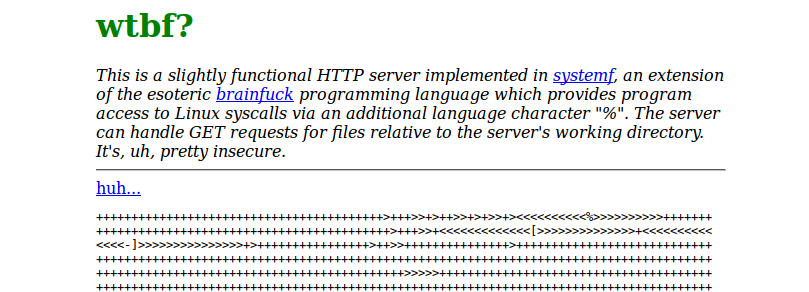ajyoon / Systemf
Programming Languages
systemf
a brainfuck interpreter supporting Linux syscalls
brainfuck is awesome, but per spec it's only able to interact with the real world via STDIN and STDOUT.
By extending the language with a special character % which executes a syscall, we can
do a whole lot more with it while having all the "fun" of working in the language.
This lets us do lots of cool things like
write an HTTP server in brainfuck:
Building:
The interpreter is written in NASM x86-64 assembly. You'll need NASM to build, and if your architecture is not x86-64 you will need to use an emulator or similar solution. Otherwise, it's as easy as:
make [build || debug || clean]
To run, call the binary on a brainfuck file:
./bin/systemf examples/hello_world.bf
Hello, World!
Interpreter rules
This interpreter features a full implementation of the brainfuck programming language. The default settings for language-unspecified rules are:
- Each cell in the program arena is a single byte with possible values 0-255
- Cell values wrap automatically between their min (0) and max (255) values
- The program arena consists of 30000 cells
- Attempting to move the cell pointer below 0 or above 29999 results in a bounds error,
and will crash the program with exit code
2 - Mismatched brackets will cause a crash with exit code
1
Syscalls
To make a syscall in brainfuck programs, this implementation introduces an
additional language character: %. When this character is encountered in
a program, the interpreter does the following:
- The value at the current cell is considered the syscall code
- The following cell is considered the number of arguments
- The following cells outline arguments in the following form:
- One cell is a flag for what type of argument this is, where 0 indicates a regular argument, 1 indicates a pointer to the argument contents in memory, and 2 indicates a pointer to a given cell number.
- One cell indicates the cell length of the argument
- The following cells indicate the argument contents. Multi-cell arguments are interpreted as bytes in big-endian form.
- The syscall is made, and its return value is dumped to the current cell.
For example, to call sys-exit, we can give the following code:
++++++[>++++++++++<-]> Write code 60 (sys exit) in cell1
> move to cell2
+ Write argument count of 1 to cell2
> move to cell3
(leave 0) Write first arg type as normal
> move to cell4
+ Write first arg cell length of 1 to cell3
> move to cell5
+++ Write exit code 3 in cell4
<<<< move back to cell1
% Call kernel
This will trigger a program exit with exit code 3:
$ ./bin/systemf examples/syscall_simple.bf
$ echo $?
3
We can use cell pointers to tell the kernel to write side effect data
directly into our program tape. For example, system read() takes in
its second argument a pointer to a buffer. To implement this in systemf
we can pass a cell pointer instead and flag it as such:
Read 5 bytes from stdin into cells 28 to 32 and print them out
(0) > Syscall code 0 for read()
+++ > Arg count 3
Arg 0~file descriptor ================================
(0) > Arg type: Normal
+ > Cell length: 1
(0) > Content: File descriptor 0 for STDIN
Arg 1~write buffer ===================================
++ > Arg type: Cell pointer
+ > Cell length: 1
+++++++
+++++++
+++++++
+++++++ > Content: Target cell 28
Arg 2~read byte count ==================================
(0) > Arg type: Normal
+ > Cell length: 1
+++++ Content: read byte count 5
Return to cell 0 and execute
<<<<<<<<<<
%
5 input characters are taken and stored in cells 28 to 32
Let's prove it:
Go to cell 28
>>>>>>>>>>>>>>>>>>>>>>>>>>>>
Print those contents out!
.>.>.>.>.>
And in execution...
systemf$ ./bin/systemf examples/syscall_read.bf
12345
12345systemf$
Other goodies
While the interpreter does not come with built-in debugging abilities, running the interpreter from GDB makes debugging quite manageable.
The interpreter offers a special pseudo-instruction $ which does nothing
except run a no-op on a label that makes it easy to attach a GDB breakpoint
at specific locations in your program.
Say you have the following brainfuck program and you want to know
exactly where you are landing after the [<] loop:
+ > + > + >
++++++++++
++++++++++
++++++++++
++++++++++
++++++++++
++++++++++
++++++++++ >
(0) > + > + > + > +
[<]
<
.
By placing a $ symbol after the [<] line and attaching a GDB breakpoint
to BF_DEBUGGING_BREAK, we can thoroughly examine the program state at
that moment:
systemf$ gdb ./bin/systemf
...
Reading symbols from ./bin/systemf...done.
(gdb) break BF_DEBUGGING_BREAK
Breakpoint 1 at 0x4002ef: file src/systemf.asm, line 197.
(gdb) run examples/breakpoint_helper.bf
Starting program: ~/systemf/bin/systemf examples/breakpoint_helper.bf
Breakpoint 1, BF_DEBUGGING_BREAK () at src/systemf.asm:197
197 nop
(gdb) info reg r15 # <-- The interpreter position in the source file (by char)
r15 0xb3 179
(gdb) info reg r13 # <-- A pointer to the current cell in the program
r13 0x619700 6395648
(gdb) x/32ub &tape # <-- View program tape state (be sure to view in "ub" mode)
0x6196fc <tape>: 1 1 1 70 0 1 1 1
0x619704: 1 0 0 0 0 0 0 0
0x61970c: 0 0 0 0 0 0 0 0
0x619714: 0 0 0 0 0 0 0 0
In debugging syscalls it is often useful to view the register states immediately before
calling. To do this simply drop a breakpoint toward the end of the sysCallExecute label
and examine the register state in GDB with info registers


